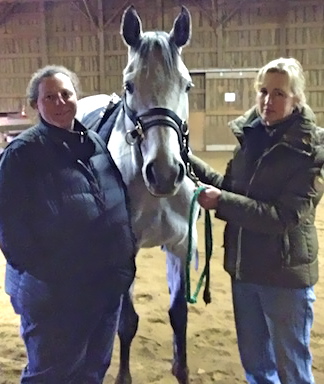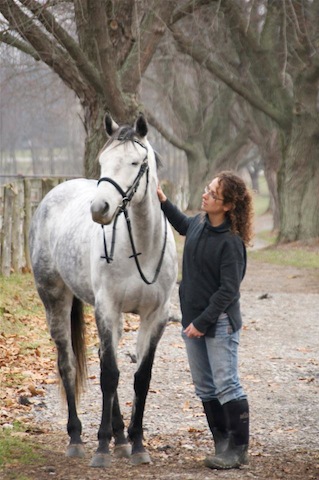Dr. Christy Cable, DVM, DACVS, announced this week that the novel Kissing Spine surgery she performed seven weeks ago on back-sore Thoroughbred Heartly Smart, previously diagnosed with the disease, appears to have completely eradicated the mare’s pain, and potentially reshaped some of the trouble-spots in the spine.
“Overall, I am very happy with her progress,” Dr. Cable says. “Her back is 100 percent pain-free right now.”
Cable adds, “At this point, I would say that I am cautiously optimistic that Heartly Smart’s back pain is going to be manageable going forward,” and that she will be able to carry the weight of a rider once more.
On Feb. 18, after a battery of treatments was tried in attempts to alleviate the mare’s back pain, Dr. Cable intervened.(Please see related story).
She decided to try a minimally invasive surgery first pioneered in the United Kingdom by Dr. Richard Coomer, DVM, on Heartly Smart. During a two-and-a-half hour procedure, done on the mildly sedated, still-standing mare, Dr. Cable followed the instructions of Dr. Coomer’s methods:
- Radiographs were taken and four areas of kissing spine were identified
- Four areas on Heartly Smart’s spine, where areas appear to touch or “kiss” were also photographed with an ultrasound to precisely pinpoint their location
- After the mare was prepped and given a sedation regimen, similar to what is prescribed for a horse undergoing a dental procedure, incisions were made at the trouble spots, and an interspinous ligament desmotomy, or cutting of the ligaments, was performed.
After weeks of recuperation and physical therapy at the facilities of Thoroughbred charity ReRun, Inc., which is partnering with Dr. Cable on the project, Heartly Smart was evaluated yesterday.
And the news was good.
“When I first tried to examine her, prior to the surgery, she would try to kick me when I attempted to get her to flex and lift her spine,” Dr. Cable says. “The more I tried this, the harder she tried to kick, and she even tried to bite me.
“Yesterday, during my follow-up examination, I was able to perform the same maneuvers, and it was absolutely no problem: she just stood there.”
Radiographs taken yesterday also reveal that two of the four trouble spots where surgery was performed, show changes. Where the spine overlapped or touched at the sites located closer toward her front, there is now more room or space, she explains. In two other surgical sites, located further away from the front, there is not any radiographic evidence that the sites have undergone structural changes. Dr. Cable however, suspects that by cutting the ligaments in those areas, pain was alleviated.
While the surgery is very promising, and evidence revealed by the radiographs is also encouraging, Cable cautions against giving too much weight to radiographs, in general, when attempting to diagnose back pain in a horse.
She explains: “Kissing Spine has always presented a conundrum to veterinarians because even though radiographs may show a horse has the condition, that horse may or may not experience symptoms,” she says. “It has been confusing for veterinarians, because even though the radiograph may be abnormal, it doesn’t mean the horse has a clinical problem that needs treatment.”
Surgical treatment, she stresses, is for animals that are clearly in pain, and for whom all other non-surgical options have been tried and ruled out as effective.
“I’ve received phone calls from all over the country from people whose horses have a radiographic diagnosis of Kissing Spine, but they’re not having pain,” she says. “These are not the horses who are candidates for the treatment.”
Before any surgical option is scheduled, the first step is always to address any back pain through other non-surgical means, including proper saddle fittings, physical therapy, injections, and other therapies, she says. Only after all else has failed does this new and promising procedure become an option, she says.
Heartly Smart will continue to undergo weeks of physical therapy to strengthen her topline. She is being cared for and exercised by Susan Swart, president of ReRun, Inc., New York chapter.
Once Dr. Cable feels the mare is capable of carrying weight again, she will be ridden under saddle.
If the mare continues to be pain free, the novel surgery pioneered by the UK veterinarian could be a breakthrough for riding horses that have been sidelined due to recurrent pain, Dr. Cable says.
“The surgery that Dr. Coomer designed offers an option for horses who had no other options. It’s a minimally invasive and straight-forward procedure” that offers a lot of hope.
She adds, “I wasn’t’ the brilliant mind who discovered it, it was Dr. Coomer. He described his methods in great detail, and I read it and thought it was brilliant.”
Off Track Thoroughbreds.com congratulates Dr. Christy Cable and Heartly Smart for their exciting work!





My 6 year old IDx was diagnosed with 3 x KS recently. His behaviour deteriorated rapidly and he became unrideable in just one week.
Steroid injections do not seem to have helped, so looking at possibility of surgery. Has anyone any negative comments/observations regarding surgery?
Immediately prior to this ‘glitch’ he was getting 70/80% in tests so desperate to give him the best possible chance of getting back to work.
Hello. I am very interested in hearing more about this. My mare was diagnosed with kissing spine just yesterday , so naturally im doing all the research I can to make informed decisions. This all started bc she had very very bad back pain and displayed many behavior issues.
I feel like it needs to be said that Texas A&M University and Kilgore Veterinary Associates in Texas has been doing a similar surgery since atleast 2011. :/ just sayin’
My 5 year old ISH mare may have kissing spines and and my vet and I are currently investigating that possibility. I would be extremely interested to hear more from any owner who has had this procedure performed on their horse, and to hear their take on the rehabilitation process (positive or negative). Was a Facebook page established this spring? If not, please shoot me an email and give me the scoop if you have a spare minute and can empathize with a fellow owner experiencing the feelings you must have all gone through yourselves – ped36@cornell.edu
Petra
My horse, Ben, had this surgery on April 3 at the University of Illinois by Dr. Matt Stewart. (Dr. Stewart’s 2nd, and I believe he has now performed a 3rd.)
Ben has improved by leaps and bounds. I am already back in the saddle to tack walk.
Is there any interest in developing a facebook page or some other site for people to post their progress?
I am so thrilled with Ben’s progress, I would love to help other horse owners help their horses.
elainetaylor@charter.net
My horses were the second and third horses to have this surgery in the US, at Tufts University performed by Dr. Jose Garcia-Lopez.
The surgery was performed on my 6 year old Thoroughbred gelding, William, who was reserve champion at his first show in the Young Hunter division. He gave us his sign of pain by rearing and Dr Randy Frantz xrayed him and he had a very severe case of kissing spines. My 12 year old Hanoverian mare was also diagnosed with Kissing Spines. She would not go straight and would grab the bit a take off. Makes me think back to all those horses that were thought to have behavioral issues, when perhaps they were just in pain. The surgery was performed on March 27,2013. We are now on week 5 and they can now go out in a small paddock and can be lunged for 10 minutes. I have already seen improvement in both horses. Can’t wait until week 8, we get X rays and should be able to start riding ! Just received my ThinLine pads and I am ready to go!
I am very thankful to Susan for getting this story to the publics attention. Without her, Olivia and the success of her surgery would not be heard. I am working very hard on Olivia’s rehab at this time and I hope that together Olivia and I show everyone great results from our hard work. I also would like the opportunity to kindly ask for your support in any way. Products like thinline pads, Back on Track blankets all contribute to a successful rehab. ReRun is a 501c3 organization that helps OTTB’s like Olivia and others. If you would like to support ReRun and sponsor Olivia please visit our website or contact me. Olivia is only one of many thoroughbreds that need a home and it is my passion to help every thoroughbred that steps into my life.
Susan,
The thanks goes to you. You’ve taken on a huge project in the rehab of Olivia and with the management of her ongoing press coverage. It’s a great thing you’re doing!!
This is such great news! We are working with vets who are utalizing the same procedure from the uk and so far all have seen great success! Once Rider’s are back up vets are recommending they add a ThinLine pad to protect the horses back. Please let us know if you would be interested in having a few trial pads. Everyone in the horse industry is thrilled this procedure is helping horses. Thank you.
Elaine@thinlineglobal.com
Oh how I wish I could afford that for my Tb mare. We have tried everything unsuccessfully to help her back pain due to her Kissing Spine. Great job to everyone involved in helping this mare. It gives me hope that maybe someday I can get my mare “fixed”. Wishing Heartly Smart a quick recovery and a nice long fulfilling life!
SUCH good news, Sue, thank you forsharing the story!
Sally, thank you! I was so excited I hopped up at 5 something to publish it!